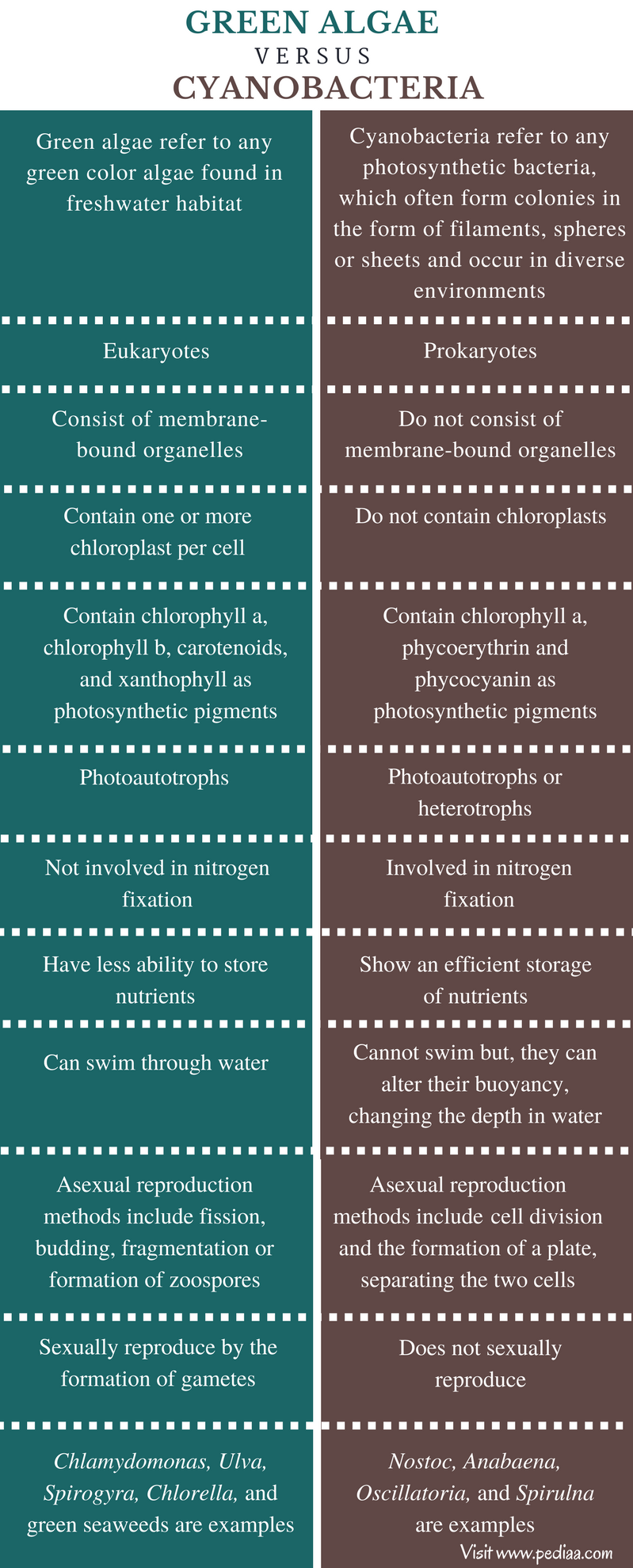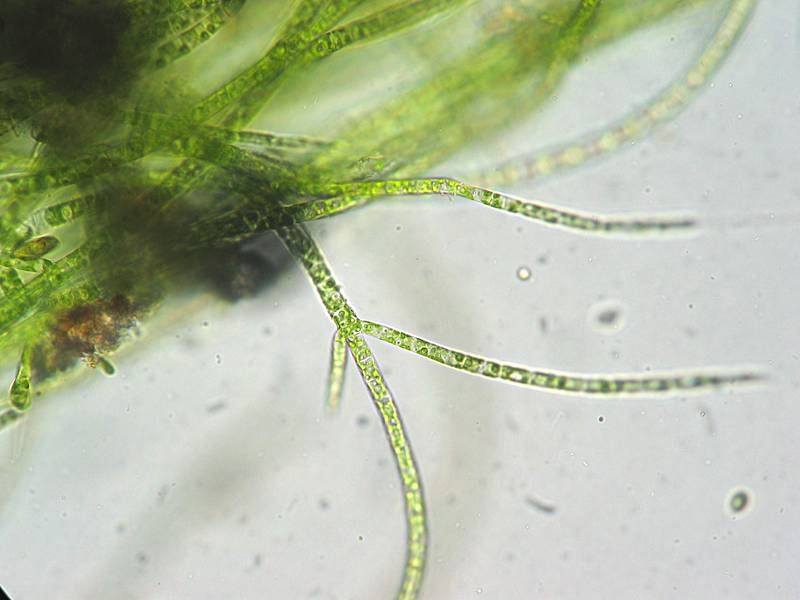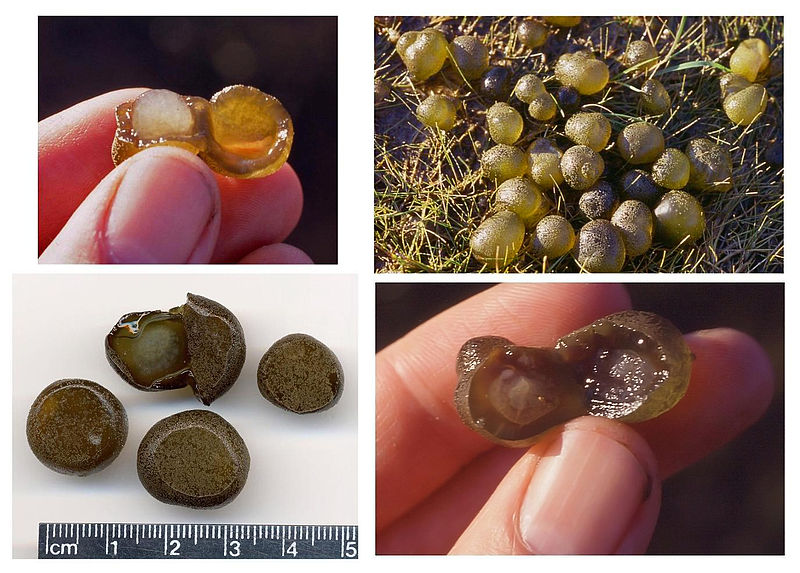Why Can Algae and Cyanobacteria Be Considered Indicators
Main Difference – Light-green Algae vs Cyanobacteria
Green algae and cyanobacteria are 2 types of photosynthetic organisms that are evolved from algae. Both green algae and cyanobacteria are very diverse organisms that are mainly establish in aquatic habitats. Dark-green algae are eukaryotes but, blue-green alga are prokaryotes. Therefore, the light-green algae contain membrane-bound organelles forth with a nucleus. In contrast, cyanobacteria do not accept membrane-jump organelles. The cyanobacteria are also called the blue-green algae. Both greenish algae and cyanobacteria are photosynthetic organisms that produce their own food by photosynthesis. Some of the cyanobacteria can be heterotrophs too. The main difference betwixt greenish algae and cyanobacteria is that green algae contain chloroplasts whereas cyanobacteria do not contain chloroplasts in their cells.
Key Areas Covered
1. What are Green Algae
– Definition, Characteristics, Types
2. What are Cyanobacteria
– Definition, Characteristics, Types
3. What are the Similarities Between Dark-green Algae and Cyanobacteria
– Outline of Common Features
4. What is the Difference Betwixt Dark-green Algae and Cyanobacteria
– Comparing of Common Features
Central Terms: Chlorophyll a, Chlorophyta, Chloroplasts, Cyanobacteria, Dark-green Algae, Heterotrophs, Photoautotrophs

What are Dark-green Algae
The green algae refer to the green colored algae constitute in freshwater habitats. The dark-green color is from the photosynthetic pigment, the chlorophyll. The chlorophyll a and chlorophyll b are the two types of chlorophyll in green algae. Green algae also incorporate beta-carotene and xanthophyll. Therefore, greenish algae are photoautotrophs and the food is stored as starch and fats. Since algae are eukaryotic organisms, they comprise membrane-bound organelles in their cells. The genetic material of dark-green algae occurs in the nucleus. Moreover, the photosynthetic pigments are arranged into chloroplasts. A single cell may contain i or more chloroplasts. Dark-green algae tin can be unicellular, multicellular or living in colonies. Some green algae show a coenocytic growth in which several greenish algae are composed of a one, large cell, without cross walls. The large cell can exist either uninucleated or multinucleated. Some green algae live in symbiotic relationships with fungi, forming lichens.
Green algae, Stigeoclonium is shown in figure 1.

Figure i: Stigeoclonium
The asexual reproduction of light-green algae occurs by fission, budding, fragmentation or by the germination of zoospores. The sexual reproduction occurs by the formation of isogamous (both gametes are motile and aforementioned size) or anisogamous (female non-motile and male motile) gametes. Most green algae evidence alteration of generations with a haploid stage and diploid phase in the life wheel. The green algae are classified into two phyla; Chlorophyta and Charophyta. Nearly Chlorophyta occurs in the marine water, freshwater or subaerial. The Chlorophyta includes Trebouxiophyceae, Chlorophyceae, Bryopsidophyceae (seaweeds), Ulvophyceae (seaweeds), Dasycladophyceae, and Siphoncladophyceae. The Charophyta entirely live in freshwater habitats.
What are Cyanobacteria
The term cyanobacteria refers to any photosynthetic bacteria. Some cyanobacteria can live as heterotrophs. Cyanobacteria can be found in the soil, and in both freshwater and marine h2o habitats. Cyanobacteria can exist either unicellular or multicellular. They class spherical-shaped, filamentous or sheet-like colonies. Some of the colonies of blue-green alga are covered with canvas-like structures. Though cyanobacteria are a type of prokaryotic organisms, they contain vacuoles inside the prison cell. The blue-green alga lack flagella just, they show a gliding movement, which occur past the trichome to change the depth inside the h2o. Some cyanobacteria are capable of fixing gaseous nitrogen. The photosynthetic pigments in cyanobacteria are chlorophyll a, phycocyanin, and phycoerythrin. Phycocyanin is a blue color pigment and phycoerythrin is a red color pigment. Blue-green alga store nutrient as starch.
The colonies of nostoc, a cyanobacterium, are shown in figure ii.

Figure two: Nostoc
The asexual reproduction of cyanobacteria occurs by cell sectionalization and the germination of a plate, separating the 2 cells. Blue-green alga do not undergo sexual reproduction.
Similarities Between Green Algae and Cyanobacteria
- Both dark-green algae and blue-green alga are evolved from algae.
- Both green algae and cyanobacteria are various organisms.
- Both green algae and cyanobacteria occur in terrestrial and aquatic habitats.
- Both green algae and cyanobacteria tin can be photosynthetic organisms.
- Some of the green algae and cyanobacteria live symbiotically.
- Both green algae and cyanobacteria can be either unicellular or multicellular.
- Both green algae and cyanobacteria incorporate vacuoles.
- Both dark-green algae and cyanobacteria store nutrient every bit starch.
Difference Between Light-green Algae and Cyanobacteria
Definition
Green Algae: Green algae refer to whatever greenish color algae found in freshwater habitats.
Cyanobacteria: Cyanobacteria refer to any photosynthetic bacteria, which often form colonies in the form of filaments, spheres or sheets and occur in diverse environments.
Type
Greenish Algae: Green algae are eukaryotes.
Cyanobacteria: Blue-green alga are prokaryotes.
Membrane-jump Organelles
Green Algae: Green algae consist of membrane-bound organelles.
Cyanobacteria: Cyanobacteria lack membrane-bound organelles.
Chloroplasts
Light-green Algae: Green algae comprise one or more chloroplast per cell.
Blue-green alga: Blue-green alga exercise not comprise chloroplasts.
Photosynthetic Pigments
Light-green Algae: Green algae contain chlorophyll a, chlorophyll b, carotenoids, and xanthophyll as photosynthetic pigments.
Blue-green alga: Cyanobacteria comprise chlorophyll a, phycoerythrin and phycocyanin as photosynthetic pigments.
Under the Light Microscope
Green Algae: Greenish algae tin can exist identified by the presence of chloroplasts in the cells.
Cyanobacteria: Cyanobacteria exhibit a homogeneous color throughout the cell.
Mode of Nutrition
Greenish Algae: Greenish algae are photoautotrophs.
Cyanobacteria: Cyanobacteria are either photoautotrophs or heterotrophs.
Nitrogen Fixation
Green Algae: Green algae practice non prepare gaseous nitrogen.
Cyanobacteria: Cyanobacteria are involved in the nitrogen fixation by utilizing gaseous nitrogen as a food.
Storage of Nutrients
Green Algae: Green algae accept less ability to store nutrients.
Cyanobacteria: Cyanobacteria evidence an efficient storage of nutrients.
Swimming
Dark-green Algae: Green algae can swim through water.
Cyanobacteria: Cyanobacteria cannot swim but, they can alter their buoyancy, changing the depth in water.
Asexual Reproduction
Green Algae: The asexual reproduction of green algae occur by fission, budding, fragmentation or past the formation of zoospores.
Cyanobacteria: The asexual reproduction of blue-green alga occurs by prison cell partition and the formation of a plate, separating the ii cells.
Sexual Reproduction
Dark-green Algae: The sexual reproduction of green algae occurs by the formation of gametes.
Cyanobacteria: Cyanobacteria practice not undergo sexual reproduction.
Examples
Green Algae: Chlamydomonas, Ulva, Spirogyra, Chlorella, and green seaweeds are examples of green algae.
Cyanobacteria: Nostoc, Anabaena, Oscillatoria, and Spirulna are examples of cyanobacteria.
Decision
Dark-green algae and cyanobacteria are 2 variants of algae. Light-green algae are eukaryotes and cyanobacteria are prokaryotes. Both greenish algae and cyanobacteria are mainly photosynthetic organisms. Green algae contain chloroplasts just cyanobacteria lack chloroplasts. Thus, the main difference between green algae and cyanobacteria is the presence or absence of chrloroplasts in the cell.
Reference:
1."The Seaweed Site: information on marine algae." Seaweed.ie :: Chlorophyta, Available here. Accessed 18 Sept. 2017.
2. Arjun, K. "Complete information on the of import characteristic features of Cyanobacteria." PRESERVE Manufactures, Available here. Accessed 18 Sept. 2017.
Image Courtesy:
1. "Stigeoclonium sp zugespitzte seitenzweige" Past Kristian Peters – Own work (CC BY-SA 3.0) via Eatables Wikimedia
2. "CyanobacteriaColl1." By Christian Fischer (CC By-SA iii.0) via Eatables Wikimedia

Source: https://pediaa.com/difference-between-green-algae-and-cyanobacteria/
0 Response to "Why Can Algae and Cyanobacteria Be Considered Indicators"
Enregistrer un commentaire